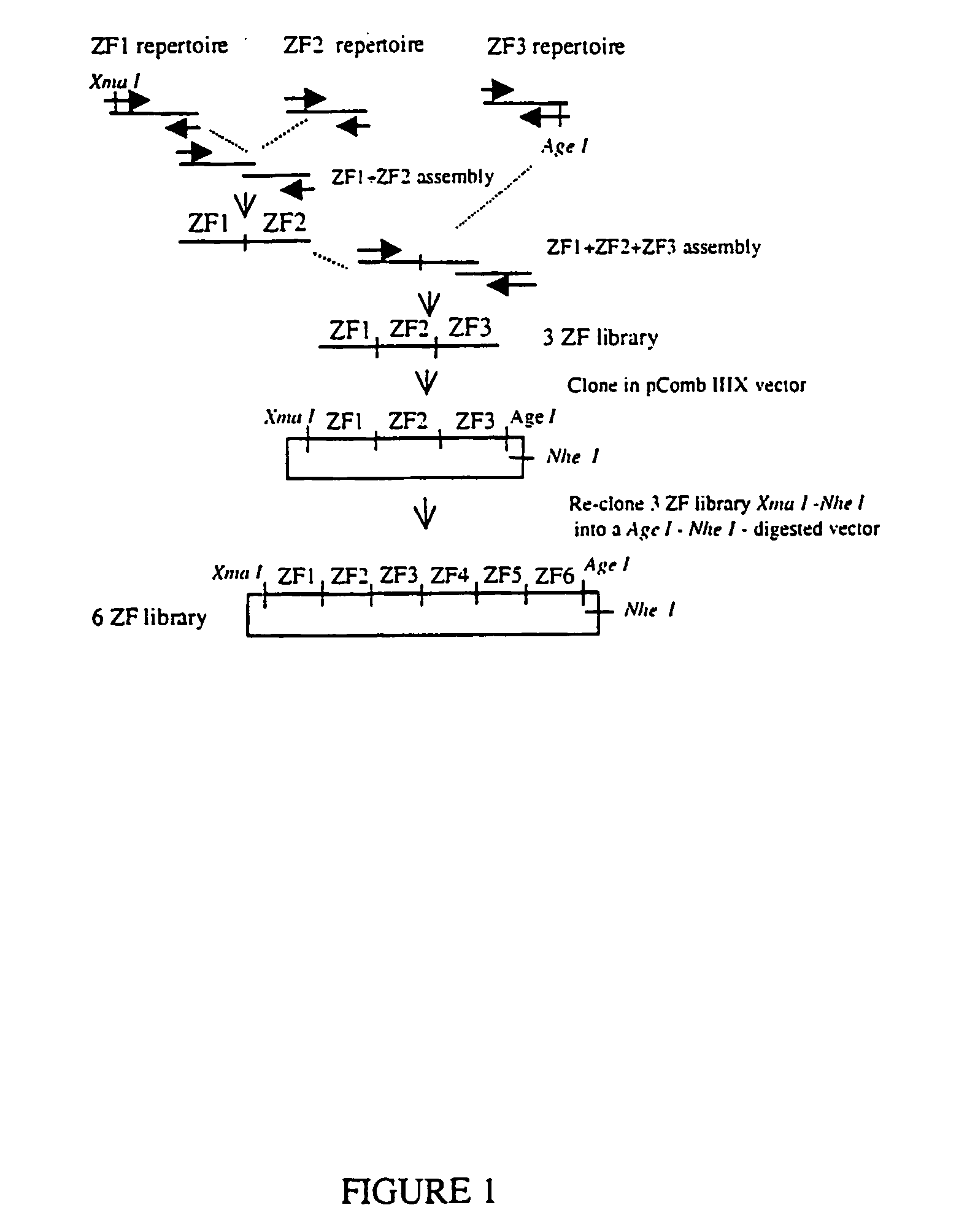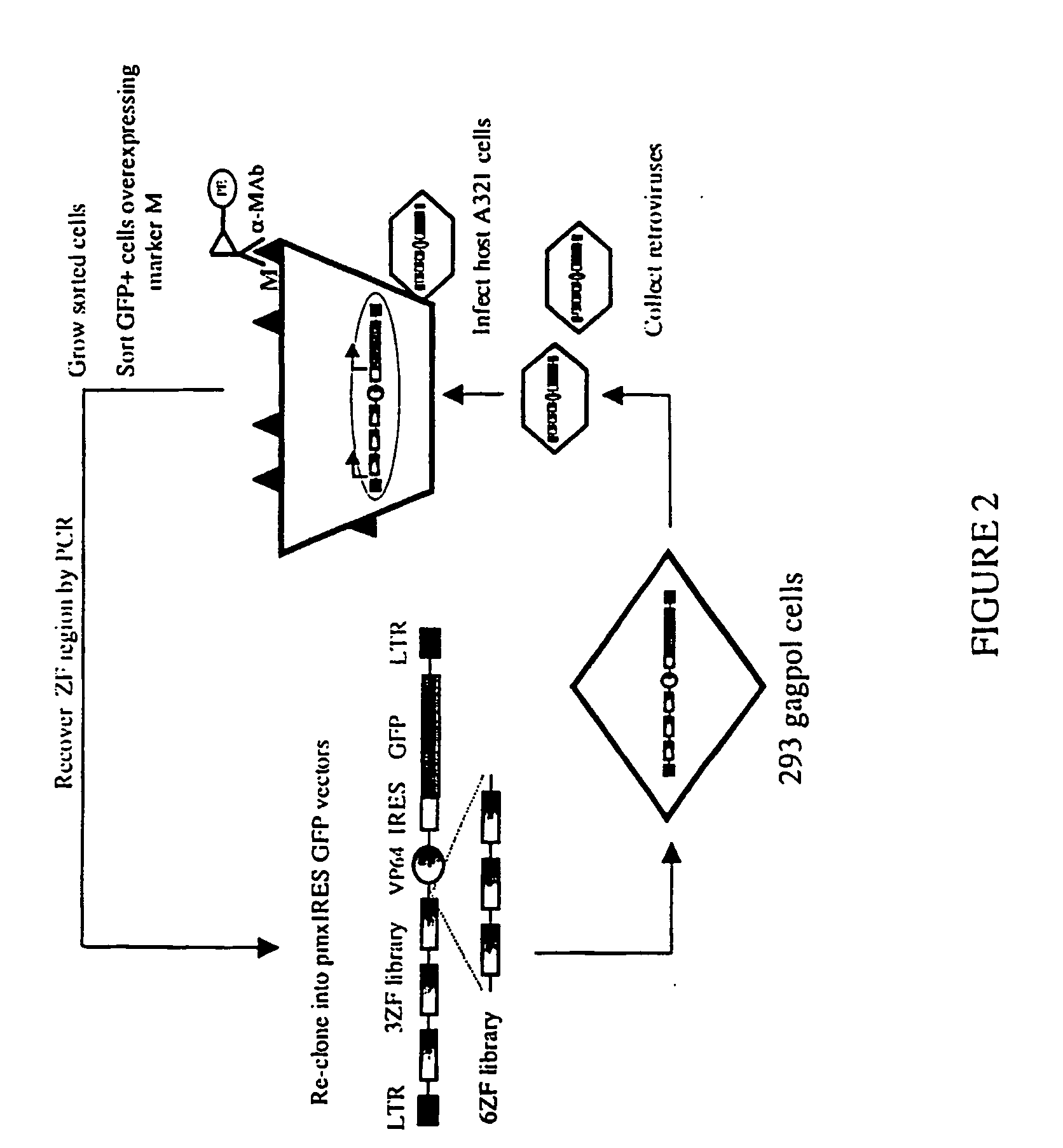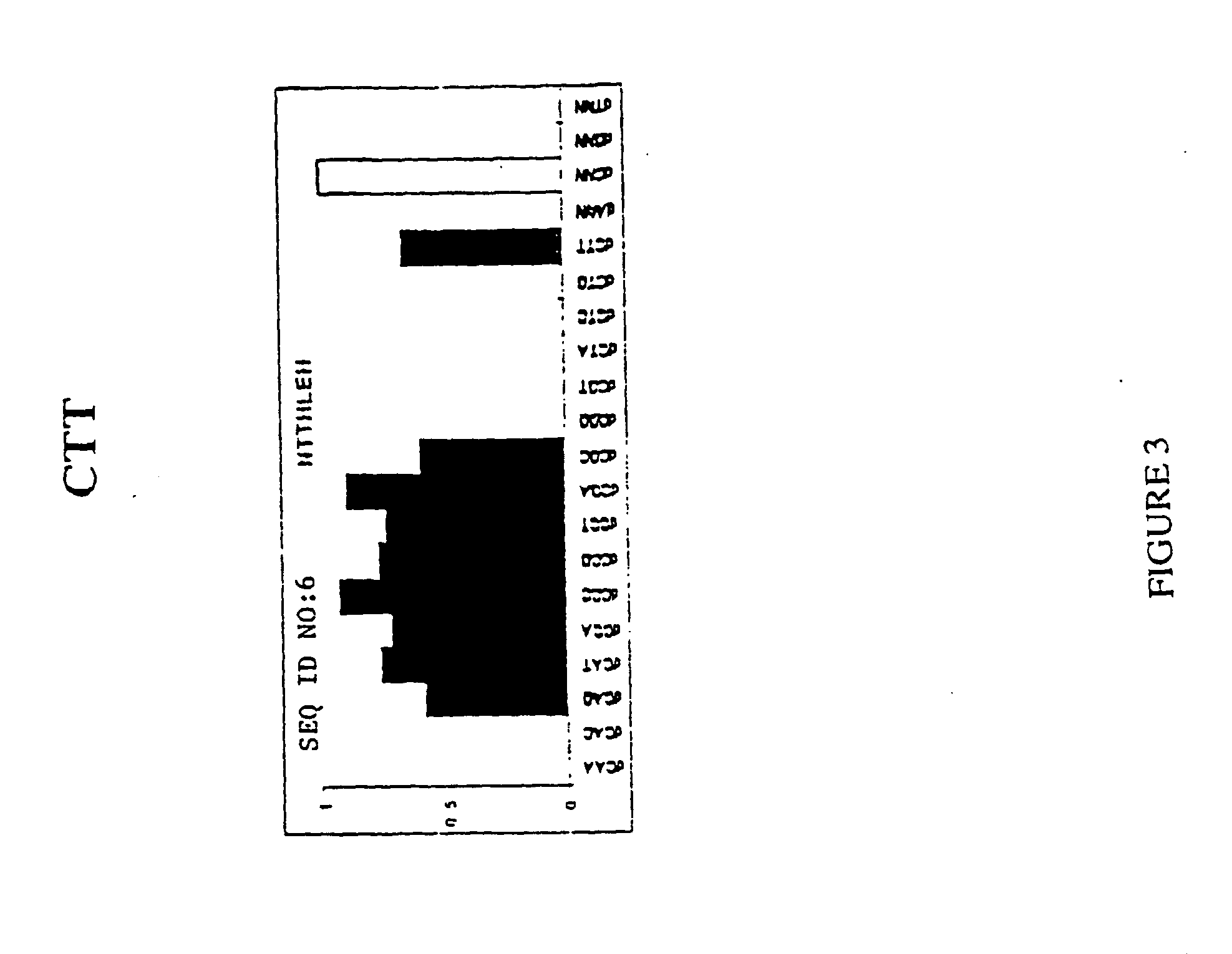Zinc finger libraries
a technology of dna binding polypeptides and zinc finger, which is applied in the field of dna binding polypeptide libraries, can solve the problems of poor or no regulation, limited knowledge of endogenous factors involved in the transcription of a given target gene,
- Summary
- Abstract
- Description
- Claims
- Application Information
AI Technical Summary
Problems solved by technology
Method used
Image
Examples
example 1
Zinc Finger Library Construction
3ZF Library (Trimeric Library)
[0073] 3 ZF library was created by overlapping PCR, mixing in the PCR reaction 23 ZF1s different DNAs, 21 ZF2s and 19 ZF3s. All DNAs used as a template for PCR were SP1 variants containing different ZF α-helices selected and characterized in our laboratory [Segal, D., Dreider, B. and Barbas III C F (1998) Proc Natl Acad Sci USA 96, 2758-2763; Dreider, B., Segal D J, and Barbas III C F (2001) J Biol Chem 276: 29466-29478.]. These templates were cloned and sequenced in pmalc2 (NEB). ZF1 library comprised α-helices specific for the triplets: 5′-GAA-3′ (helix QSSNLVR) (SEQ ID NO:1), 5′-GAC-3′ (DPGNLVR) (SEQ ID NO:2), 5′-GAG-3′ (RSDNLRR) (SEQ ID NO:3), 5′-GAT-3′ (TSGNLVR) (SEQ ID NO:4), 5′-GCA-3′ (QSGDLRR) (SEQ ID NO:5), 5′-GCC-3′ (DCRDLAR) (SEQ ID NO:6), 5′-GCG-3′ (RSDDLVR) (SEQ ID NO:7), 5′-GCT-3′ (TSGELVR) (SEQ ID NO:8), 5′-GGA-3′ (QSSHLVR) (SEQ ID NO:9), 5′-GGC-3′ (DPGHLVR) (SEQ ID NO:10), 5′-GGG-3′ (RSDKLVR) (SEQ ID NO...
example 2
Library Transfection
[0075] The pmxires GFP-3ZFlibrary-VP64 was transfected in 293gagpol cells (Clontech) as follows: 7.8 μg of ZF library was cotransfected with 2.5 μg of pMDG.1 vector (in order to express the Envelop protein of the retrovirus) [Beerli, R. et al. (2000) Proc Natl Acad Sci USA 97, 1495-1500] in a 15 cm tissue culture plate (VWR) per target gene. Transfection was performed using lipofectamine plus (Gibco) according to the manufacturer's instructions. A pEGFPN1 (Clontech) vector was transfected also as a control to determine the percentage of infection and pcDNA3.1 (Invitrogen) was used as a negative control for infection. After 48 hr the supernatant containing the virus was collected and used to infect A431 cells (3×105 per target gene) in a 15 cm plate. Cells were collected 72 hr later for flow cytometry studies.
[0076] The pmxires GFP-6ZFlibrary-VP64 was transfected as follows. 1×108 293gagpol cells were transfected with 117 μg of 6ZF library and 39 μg of pMDG in a...
example 3
[0077] Infected A431 cells were stained with 11 different anti-human antibodies specific for A431 cell surface markers: anti-CD 15, anti-erb2 (clone SP77, [Beerli, R. et al. (2000) Proc Natl Acad Sci USA 97, 1495-1500]), anti-erb3 (clone SPG1 NeoMarkers, Fremont, Calif.), anti-CD104 (clone 450-9D), anti-CD144 (clone 55-7H1, PharMingen), anti-CD54 (clone HA58, PharMingen), anti-CD58 (clone 1C3 (AICD58.6), PharMingen), anti-CD95 (Clone DX2, PharMingen), anti-EGRF1 (Santa Cruz Biotechnology), anti-CD49f (clone GoH3, PharMingen) and anti-PrP (prion protein, a gift from Dr. Anthony Williamson at The Scripps Research Institute, only for the 3ZF library). Typically 107 cells were stained in 300-500 ml of FACS-sorting buffer (FACSB, 1×PBS (metal free), 1 mM EDTA, 25 mM HEPES, pH 7.0 and 1% of calf serum (VWR) with the primary antibody at a concentration of 5 μg / ml. Cells were washed twice with FACSB and incubated with a secondary anti-human-PE antibody (PharMingen) at 1:100 d...
PUM
| Property | Measurement | Unit |
|---|---|---|
| length | aaaaa | aaaaa |
| size | aaaaa | aaaaa |
| affinity | aaaaa | aaaaa |
Abstract
Description
Claims
Application Information
 Login to View More
Login to View More - R&D
- Intellectual Property
- Life Sciences
- Materials
- Tech Scout
- Unparalleled Data Quality
- Higher Quality Content
- 60% Fewer Hallucinations
Browse by: Latest US Patents, China's latest patents, Technical Efficacy Thesaurus, Application Domain, Technology Topic, Popular Technical Reports.
© 2025 PatSnap. All rights reserved.Legal|Privacy policy|Modern Slavery Act Transparency Statement|Sitemap|About US| Contact US: help@patsnap.com



